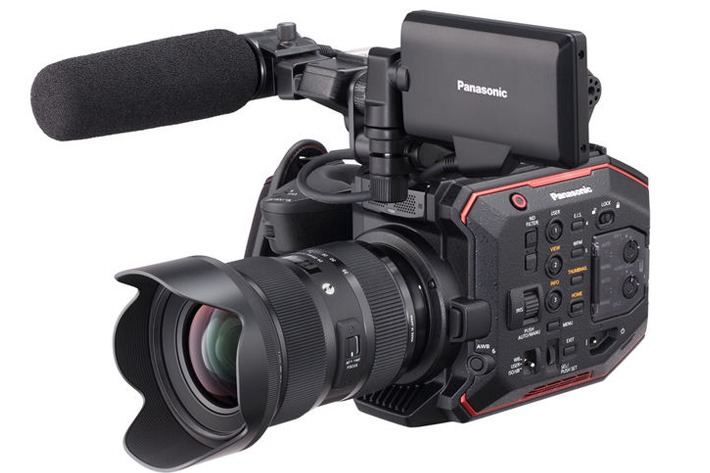
Cine Gear Expo 2017 is the stage for the presentation of new compact cameras for small crews: Canon had the C200, Panasonic, finally, unveiled the AU-EVA1.
Previewed at Cine Gear Expo 2017 and available this Fall, the AU-EVA1 is a new 5.7K cinema camera positioned between the Panasonic Lumix GH5 4K mirrorless camera and the VariCam LT 4K cinema camera. Compact and lightweight, the AU-EVA1 is tailor-made for handheld shooting, but also well suited for documentaries, commercials and music videos.
“For cinema-style acquisition, we realized there was a space between the GH5 and the VariCam LT,” said Panasonic Cinema Product Manager Mitch Gross. “With its compact size and new 5.7K sensor, the EVA1 fills that gap for a variety of filmmaking applications.”
As suggested by the images published before, the new Panasonic AU-EVA1 uses a Canon EF-mount. While some people expected a camera to sit above the GH5 and under the Varicam line to offer a MFT mount, so lenses from the Lumix GH5 could be used, the truth is that the newly designed 5.7K Super 35mm-sized sensor would not work with MFT lenses, so the EF-mount was chosen.
Panasonic explains that the choice of the EF-mount makes sense, at it gives shooters access to the broad EF lens ecosystem, including dozens of cinema-style prime and zoom lenses from numerous manufacturers. The EVA1 offers Electronic Image Stabilization (EIS) to compensate for camera shake and blurring, which will help smooth out handheld or shoulder-mount shots on documentary or run-and-gun projects. Behind the lens mount, an integrated ND filter wheel in 2, 4, and 6 stops allows for precise exposure control. The EVA1 also allows the IR Cut filter to be swung out of the path to the sensor at the push of a button. Unique photographic effects and night vision imagery are possible with this control over infrared.
Comparisons with the Canon EOS C200 are more than natural at this stage, as both models seem to aim at similar types of users, besides having similar price. With this “war” in compact models, Sony took the opportunity to say they have plans for something completely different, with a new CineAlta camera.
As mentioned above, the camera contains a newly designed 5.7K Super 35mm-sized sensor for capturing true cinematic images. Panasonic says by starting at a higher native resolution, the 5.7K sensor yields a higher resolving image when down sampled to 4K, UHD, 2K, and even 720p. The increased color information results in a finer, more accurate finished image.
The Panasonic AU-EVA1 presented at Cine Gear Expo 2017 is still not the final camera, as the company wants to introduce features that are still being tested, some imported from the Varicam family with which this camera has strong bonds, although not being a “true” member of the Varicam line.
One of the key features of the VariCam 35, VariCam LT, and VariCam Pure is Dual Native ISO. Utilizing a process that allows the sensor to be read in a fundamentally different way, Dual Native ISO extracts more information from the sensor without degrading the image. This results in a camera that can switch from a standard sensitivity to a high sensitivity without an increase in noise, or other artifacts. On the VariCams, Dual Native ISO has allowed cinematographers to use less light on set, saving time and money, as well as allowing for a great variety of artistic choices. The EVA1 will include Dual Native ISO, but the camera is currently being tested to determine final ISO specifications.
The ability to capture accurate colors and rich skin tones is a must for any filmmaker. Like the VariCam lineup of cinema cameras, the EVA1 contains V-Log/V-Gamut capture to deliver high dynamic range and broad colors. V-Log has log curve characteristics that are somewhat reminiscent of negative film and V-Gamut delivers a color space even larger than film. The EVA1 will also import the celebrated colorimetry of the VariCam line.
Weighing only 2.65-lbs (1.2Kg, body-only) with a compact form factor (6.69” x 5.31” x 5.23”) and a removable handgrip, the EVA1 can be used for efficient handheld shooting applications and can also be mounted on a drone, gimbal rig or jib arm for complex yet smooth camera moves. There will also be numerous mounting points and Panasonic is currently working with top accessory makers to allow further customization with the EVA1.
Ideal for indie filmmakers, the EVA1 records to readily-available, lower-cost SD cards, an interesting options that many will appreciate. The camera can record in several formats and compression rates, and offers up to 10-bit 4:2:2, even in 4K. For high-speed capture, the EVA1 offers 2K up to 240-fps. In terms of bitrates, you can record up to 400-Mbps for robust recording. A complete breakdown of recording formats will be available at the time of the EVA1’s release, says Panasonic.
Panasonic’s Cinema Product Manager, Mitch Gross, says that “art of the design ethos of the camera was to not only make the camera itself affordable but it had to be affordable to use. The EVA1 uses SD cards to record footage and it can record in various codecs, including 4K 10-bit 422 to fast SDXC cards. The cards are readily available everywhere in the world so if you’re a documentary shooter in a remote location, you can purchase more cards and stick them in the sides of most laptop computers, or pick up an adaptor at any electronics store. The usability of the camera is high and the expense is kept at a minimum. Depending on the selected format we require cards that can do certain read and write speeds and all that information will be made available when the camera ships.”
As a professional video production tool, the Panasonic EVA1 offers dual balanced XLR audio inputs and 4K-capable video outputs in both HDMI and SDI. In a future firmware upgrade, EVA1 will offer 5.7K RAW output to 3rd party recorders.
